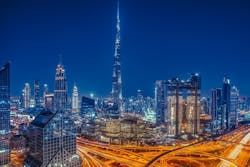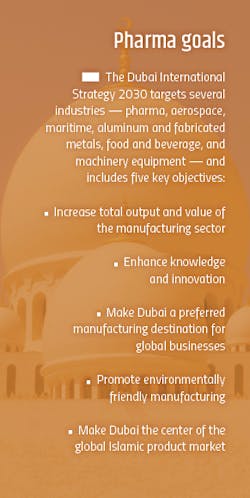Even at night, the cities seem to shine in the United Arab Emirates. With the second biggest economy in the Middle East, the UAE has become known for dazzling opulence and some of the most notoriously grand construction projects in the world: a cluster of upscale homes and hotels built in the shape of a palm tree in the sea, the tallest skyscraper on the planet, and many of the Arabian peninsula’s most expensive buildings.
But course, much of the country’s wealth was bought with petrodollars, which UAE leaders are wise enough to know won’t be rolling in forever. So in the last decade, the story of the UAE, which is made up of seven emirates, has been mostly about the country’s quest to diversify its economy and to become a new home for a number of bustling industries — pharma among them.
In the last five years, the UAE government has unveiled two major plans — the Dubai Industrial Strategy 2030 and Abu Dhabi Vision 2030 — aimed at propping up high-growth sectors in the country. Both economic strategies for the country’s two largest cities have named the pharma industry as a priority for development.
So far, the country’s pharma manufacturing landscape is dominated by generics producers and CMOs. But the UAE wants to change that and is laying the groundwork to attract more multinationals to develop and produce innovative medicines on its shores.
With a stunning track record of success in construction achievements, the question now is: Can the UAE build a sparkly, new pharma manufacturing industry as well?
Pharma’s presence
Although the UAE isn’t home to a large number of pharma manufacturing plants, most of the industry’s major players have chosen the country — and especially Dubai — as their regional hub. Similar to the role Singapore plays in southeast Asia, Dubai’s favorable tax environment, well-developed infrastructure and bustling labor force have made it an attractive home for administrative offices. In pharma, this means that most of the big companies’ management, marketing and sales staff work from Dubai to manage the region — including the UAE’s pharma market, which the Dubai Chamber of Commerce and Industry estimates is worth about $3 billion (and growing).
Despite having a strong business presence in Dubai, none of the Big Pharma companies are producing drugs in their own facilities in the UAE just yet. According to Dream Samir, the secretary general for the Pharmaceutical Research and Manufacturers Association Gulf (PhRMAG), only three branded drug products being manufactured in the UAE through contractors. Otherwise, manufacturing facilities generally produce generic drugs for a range of common ailments.
On the whole, the UAE is better developed for tourism and office jobs than it is for manufacturing. And Samir points out that the regulatory cost of doing manufacturing business is on the “high side” as well. For example, one of the country’s assets — its labor force — creates additional red tape issues.
Constructing modern metropolises in the desert has been no small task, and the country has relied heavily on migrant workers to pull it off — so much so that an estimated 90 percent of the people living in the UAE are now from other countries. With so many migrant workers in the labor force, residency visas for employees can pose an additional cost to companies.
Fadi Smeirat, partner and MENA life sciences consulting leader at EY, says that the overall higher cost of living can also have an impact on the price of labor at manufacturing facilities — posing some challenges to companies in the low-margin market of generics.
“The cost of talent is higher than the rest of the region because the cost of living is higher,” Smeirat explains. “The lifestyle, taxes, housing; the whole economy is geared towards making a lot of money, but also spending a lot of money in the country.”
In addition, Samir says that operational costs for various issuing and legalizing certificates, import and export licenses and “basically anything you have to legalize and stamp” are high in the UAE. Yet, Samir argues that these costs are not “prohibitive” and that the manufacturing industry is starting to rev up.
So far, there are 15 pharma factories in the UAE. Although that doesn’t sound like a lot, Samir points out that about 35-40 facilities have applied for licensing applications and are waiting for approval. And the number of pharma plants is also robust relative to the country’s population of 10 million. By comparison, Samir points out that Egypt has about 100 plants and a population of nearly 100 million.
“You could argue that the pharma industry [in the UAE] is well developed given the size of the country,” Samir says.
And the country is taking definitive steps to make itself more attractive to foreign investment from multinational pharma firms.
Incentives for pharma
Although Smeirat says there is still some uncertainty about what exactly the government is going to do to grow its pharma manufacturing prowess, some specific measures have already taken effect.
“Traditionally, you could not establish a trading company without 51 percent ownership of a local entity,” Samir explains. “Imagine that Pfizer, for example, wants to establish a local entity — previously, they would have had to partner with a local company to do that, which means that they would not have been full owners of their factory.”
Now, Samir says that the UAE allows multinational companies to have 100 percent ownership of their operations.
“It’s a brave decision — not only for pharma but for all industries,” Samir says. “It encourages multinationals to invest in the UAE.”
Smeirat says that the government authorities in both Dubai and Abu Dhabi and their foreign investment arms are still trying to determine exactly what the legal ramifications of the 100 percent ownership rule will be and what sort of incentives could be given to multinationals to invest in local manufacturing facilities. But the impact could mirror what happened in the Kingdom of Saudi Arabia (KSA) a few years ago when the country began allowing 100 percent ownership of companies, which boosted the economy and improved patient access to medicines.
The UAE is also looking at ways to streamline its regulatory processes. Although the registration time for new drugs in the country is already one of the fastest in the region, Samir says “the UAE is raising the bar,” when it comes to speed.
“Registration time can be as short as three months,” Samir says.
In October, the UAE also passed an important measure protecting intellectual property rights. Called Decree 321, Samir says the “big milestone” impacts regulatory data protection and ensures that files cannot be given to other companies who want to produce generics.
“There was a lot of anxiousness over this,” Samir says. “Decree 321 has now created comfort in the industry.”
But to continue expanding its manufacturing capacity, regional experts argue that the UAE should rely on the aspect of its pharma infrastructure that is already well developed.
Field of dreams
According to Samir Khalil, the executive director, Middle East & Africa, PhRMA, if you build a solid clinical trials infrastructure, manufacturing will come.
“If you look at our industry…the big value that we bring to the country is in clinical trials,” Khalil says. “[The UAE has] great hospitals, universities and very qualified [health care] professionals, and is taking solid steps forward to have an ecosystem that attracts investment in the biopharma industry.”
Samir says that the number of clinical trials in the UAE is on the rise and that attracting more will be a win for the industry — and the country’s economy as a whole.
“We want to be on par with Singapore and Switzerland, which has a huge number of clinical trials,” he says. “A typical pharma company spends billions on research, which goes to a select number of countries with good clinical research capabilities. It boosts supporting industries and the whole economy.”
“Manufacturing is very important, but the long-term investment is in clinical research,” Khalil says.
Going forward
Although Smeirat says that there are still issues for companies in the UAE, there is also motivation to continue making productive changes for the industry.
“One of the main challenges in the region is the alignment between the different governmental authorities,” Smeirat explains. “But change is underway. The mindset of the whole region, especially in the UAE and KSA, has been very open to transformation and world-class changes. You can see that from the other successes in the country.”
Samir points out that harmonization between pharma regulators in the UAE and global regulatory bodies could be one of the next measures implemented to improve the business climate of the industry.
“If a drug is approved in one country, you could rely on this for approval in the rest of the region,” he says. “This mutual recognition would greatly help.”
If history is any indicator, the UAE is likely to succeed on its quest to build out its pharma industry into a new hub of manufacturing in the region.
“They are moving in the right direction,” Khalil says. “The pricing system is reasonable. The regulatory system is fast. They are doing well on all levels. It’s a model country in the region.”
Top image of Dubai courtesy of ZQ Lee via Unsplash.com.





